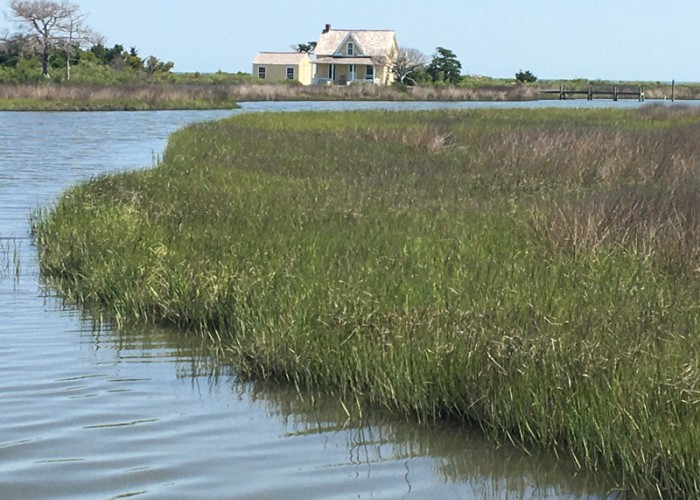The Keeper of Pea Island
Richard Etheridge and his historic life-saving station
By Donna Campbell SmithOn June 28, 1848, in order to “save lives from the perils of the sea,” the U.S. Federal government began funding volunteer lifesaving efforts along the Atlantic coast — an act that sowed the seeds of what would become the U.S. Life-Saving Service.
North Carolina’s coast, known as the graveyard of the Atlantic, was in dire need of this service. In all, there were 29 life-saving stations along the North Carolina coast, spaced about six miles apart from the Virginia line to the South Carolina border. Each station had a commanding officer, called the keeper, and a staff of six surfmen.
Of those North Carolina stations, one stands out as unique in American history: the Pea Island Life-Saving Station in Rodanthe. This was the only one of approximately 450 stations in the country to be commanded by a Black keeper, and the only life-saving station with an all-Black staff.
Before the Pea Island station rose to this distinction, however, there were problems reported within the North Carolina network of stations. Lives were not being saved. Between 1876 and 1878 there were three major wrecks along the North Carolina coast, and 211 lives were lost. The wreck of the schooner M&E Henderson was the straw that broke the camel’s back. National news covered the story and reported four lives were lost. Three survived only because they got ashore on their own. Investigators learned that the keeper and some of the surfmen of the Pea Island station were absent at the time of the shipwreck. Help arrived too late because the absentees had gone hunting.
They wanted men who knew the sea and had the best work ethics. One name kept coming up: Richard Etheridge. Richard Etheridge was a Black man, born a slave in 1842 on Roanoke Island in Manteo.
General Superintendent Summers Kimball began an investigation. His investigations revealed the stations’ keepers were not knowledgeable seamen. The position of keeper was a prestigious one. It was found that keepers were placed in these positions because of who they knew in high places rather than their ability and knowledge of the sea. While there were some Black surfmen who had grown up working on fishing boats and did know the sea, there certainly were no Black keepers.
U.S. Life-Saving Service Inspectors Frank Newcome and Charles Shoemaker were assigned to conduct further investigations. Newcome asked for names of the best surfmen of the life-saving stations. They wanted men who knew the sea and had the best work ethics. One name kept coming up: Richard Etheridge. Richard Etheridge was a Black man, born a slave in 1842 on Roanoke Island in Manteo. He had been illegally taught to read and write by his owner, John B. Etheridge.
Richard Etheridge enlisted in the Union Army in 1863, serving in the 36th U.S. Colored Troops. He became a sergeant. After the war, Etheridge came back to the Outer Banks, married, and returned to working as a fisherman. He joined the staff of the life-saving station at Oregon Inlet in 1875 and later was transferred to the Bodie Island station, holding the lowest ranking job.
Newcome and Shoemaker recommended Etheridge for the position of keeper of the Pea Island Life-Saving Station. He was hired. His training in the U.S. Army gave him the skills to be a good leader. The surfmen were a “checkerboard” crew, meaning they were made up of both white and Black men. The white men did not want to work under a Black superior and resigned. Etheridge recruited Black men from other stations to fill the vacated spots, making Pea Island Life-Saving Station the first and only all-Black staff in the country.
There was resistance in the white community. They threatened the Black workers. In 1880 the Pea Island station was burned to the ground. But that was not the end of the Pea Island station. It was rebuilt and Etheridge carried on with his job. He took to his responsibilities like he’d learned in the military, conducting daily drills with the life-saving equipment, and testing the men on their knowledge.
On Oct. 11, 1896, the Pea Island crew was put to the true test when the E.S. Newman ran aground south of the station during a hurricane. Etheridge immediately assembled his crew when he saw the distress signal. The storm was too violent to use the life-saving equipment. Etheridge issued an order that line be tied between his two strongest surfmen, who were then tethered to shore, and that they “go down through the surf as near the side of the vessel as possible.” They then carried each survivor safely ashore, one-by-one. All nine people aboard the Newman were rescued that night, and as Etheridge noted in his log, “the voice of gladden hearts greeted the arrival of the station crew.”
Etheridge worked as keeper of the Pea Island station for 20 years. In January 1900, he became sick and died at the station. The Pea Island Life-Saving Station continued to be staffed by an all-Black crew until it was decommissioned in 1947.
The legacy of Etheridge and the Pea Island Life-Saving Station remains an important part of our state and national history, and a point of pride in the local community.
“If we are to promote unity, love and community, we need to provide inclusivity and exposure of all history in Dare County such as Captain Richard Etheridge and the all-Black life-saving station at Pea Island, the enslaved and the free,” says Coquetta Laverna C. Brooks, secretary of the Pea Island Preservation Society. “The beauty of a fabric is in the detail, and the detail is in the thread. We are all pieces of thread!”
-
Island life
-
Share this story:








